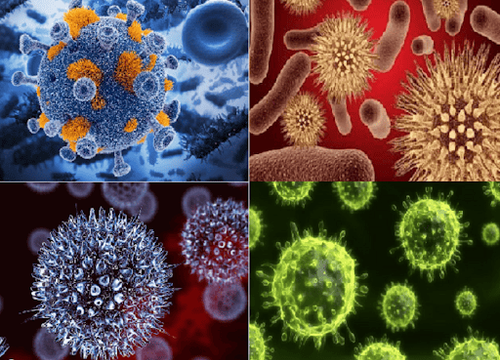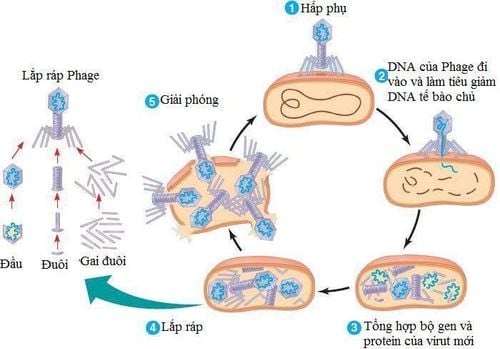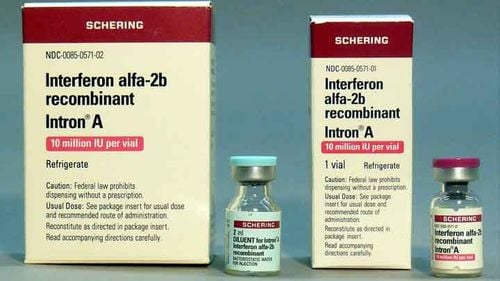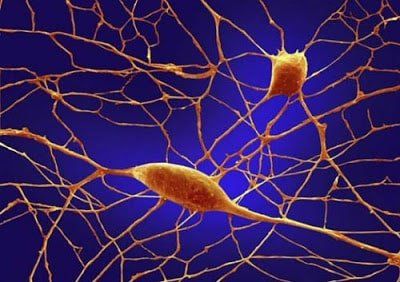This is an automatically translated article.
Viruses are microscopic organisms. Viruses replicate completely only in the living cells of their hosts (bacteria, plants, or animals). The following is basic information about viruses, the viral replication cycle in host cells.
1. What is a virus, what are its characteristics?
Viruses are one of the smallest and simplest organisms. Viruses have no cellular structure, no metabolism, and cannot reproduce on their own.
The size of viruses is very small, many times smaller than bacteria. Most viruses are between 50 and 300 nm (nanometers) in size. 1 nanometer = 1/1000 micrometer.
Each virus will have a certain size and will not change during development. Based on size, people divide viruses into 3 types:
Small type: Virus size is less than 100nm; Medium type: Virus size from 100 - 200nm; Large type: Virus size 200 - 200nm. Each type of virus has a certain shape with its own characteristics. Common viral forms include:
Spherical: Influenza, measles, HIV, polio viruses; Polyhedron: Herpes virus, Adeno virus; Other shapes: Stick shape, thread shape, bullet shape, brick shape, drumstick shape,...

Một số loại virus có hình dạng khác nhau
2. What is the replication cycle of viruses like?
Viruses have no cellular structure, no metabolism, and cannot reproduce on their own. Therefore, viruses only live when parasitic in living cells (actually using amino acids, enzymes, nucleotides, energy sources, ... of living cells to synthesize new viruses). Viruses must parasitize living cells.
In fact, the viral replication cycle in the host cell is the process by which the virus transmits their genetic information to the host cell, forcing the host cell to act according to the information of the virus, synthesizing the components of the virus. .
2.1 Ways of Virus Replication The way a virus replicates depends on the type of nucleic acid. In the process of viral replication, many enzymes (both virus and host cell) are involved.
Ways of replication include:
Replication of viruses containing DNA; RNA virus replication; RNA viruses need DNA to replicate. 2.2 Stages of the viral replication cycle The viral replication cycle is divided into 4 stages:
Cell invasion and attachment phase: Each virus can only attach to the surface of a certain number of cells. fixed (receptor cells). These cells have virus-specific receptors (receptors). Once inside the cell, the viral capsid is broken down by an appropriate enzyme, releasing nucleic acids. Some enveloped viruses can penetrate by fusion with the host cell membrane, nucleic acids will be released into the cell cytoplasm; Phase of creating viral components: After removing the capsid, the virus enters the latent stage, no virus particles are seen in the cell. At this stage, the virus transmits genetic information to the host cell, the host cell redirects the activity of the cell's metabolic machinery to synthesize viral components. The viral genome multiplies, forming the new viral nucleic acid; Viral component assembly phase: Viral envelope proteins assemble themselves with nucleic acids to form new viruses. Assembly can take place in the cytoplasm or nucleus of the host cell. Successful assembly produces complete, infectious viruses (virions); Stage of exiting the host cell: After being assembled, the viruses will close to the cell membrane to escape by budding or exiting in a massive manner that disrupts and destroys cells. With the above viral replication cycle, the replication time of viruses is much shorter than that of bacteria. For example, from the original virus, one cell infected with the flu virus can produce thousands of new viruses after only about 5-6 hours.

Chu trình nhân lên của virut trong tế bào chủ
3. What are the consequences of viral replication?
For the whole body:
Viruses cause acute, chronic, latent and slow viral infections; With the immune system, the virus stimulates a specific immune response; Viral infections can cause temporary immunodeficiency (in children after measles) or permanent immunodeficiency (HIV/AIDS infection). For cells infected with viruses:
Cells are destroyed; Cells and viruses coexist: provirus; Cells produce inclusions; Cells with damaged chromosomes; Cells proliferate indefinitely, causing tumor or cancer formation; Stimulates cells to produce Interferons - low molecular weight glycoproteins that inhibit viral replication.
4. Virus treatment
Commonly used viral treatments include:
Antiviral therapy: Antiviral drugs are used to target multiple stages of viral replication, helping to erode viral granulation with or without host cell membranes. binds to viral nucleic acids; It inhibits cell receptors or viral replication factors, and blocks viral-encoding enzymes and proteins. Antiviral drugs are often used in the treatment or prevention of: HIV, respiratory virus, hepatitis B, hepatitis C, herpes virus,...; Interferons: Compounds released from virus-infected host cells in response to viral or other foreign antigens. There are many different interferons, have many effects such as: blocking translation, viral RNA replication, blocking viral replication, ... without affecting the function of the host cell. Viral diseases that can be treated with interferon therapy include: Chronic hepatitis B and C, genital warts,...

Interferon thường được sử dụng trong điều trị virus viêm gan B và viêm gan C
5. Virus prevention measures
There are many virus prevention measures used including:
Vaccines: Works by stimulating the body's immunity. There are many vaccines available such as: Hepatitis A, Hepatitis B, Japanese Encephalitis, Measles, Mumps, Polio, Rabies, Rubella, Chickenpox, Yellow Fever, Smallpox,...; Immunoglobulins: Prophylactic passive immunity in some cases. They can be used pre-exposure, post-exposure or therapeutic use; Protective measures: Wash hands often, avoid contact with infected people, practice safe sex,... Because viruses are not capable of self-replicating, apart from living cells, the virus's replication cycle is only can be carried out within the cell (thanks to host cell metabolism). Virus replication is a complex, multi-stage process. Everyone should pay attention to learn information about viruses, proactively prevent and treat diseases caused by viruses early.
Please dial HOTLINE for more information or register for an appointment HERE. Download MyVinmec app to make appointments faster and to manage your bookings easily.













